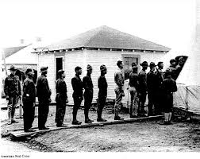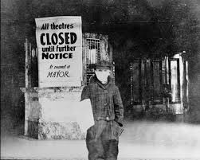A flu pandemic in 1918–1919 killed more people around the world than the world war that ended that year. The influenza has come to be known by a handful of names, the most familiar of which is the Spanish Flu.
The flu did not strike in just one spot at one time; it developed from multiple places around the globe. Several origin stories have been put forward through the years. One of the most prominent was that of an American soldier reporting to the infirmary at Fort Riley, Kan., with a fever, which turned out to be the terrible influenza that would kill so many so quickly.

That soldier, Albert Gitchell, reported that fever on March 11, 1918; subsequent research has determined that he might have had the flu for a week before he went to the infirmary. He was joined in those unfortunate circumstances by more than 100 other soldiers on that day alone; by the end of a week, the number was up to 500. The diagnosis in every case was pneumonia. Dozens of the afflicted died.
The flu virus, as it was later discovered to be, spread through that armed services camp and through others (for it wasn't just the Midwestern camp in which the flu virus was lurking) and then traveled with American soldiers who went to the front in World War I, which was still raging in spring 1918. Conditions in the trenches in Europe were found to be conducive to the spreading of all manner of diseases, and this newly discovered strain of influenza spread quickly and became very deadly.
The newly discovered flu virus didn't kill everyone who contracted it; the death rate was higher than than previously observed, however.
This strain of the flu killed young adults much more easily than others, proving especially deadly in age groups of 20 to 40. One study found that the death rate for people in that age group was 20 times higher in 1918 than in previous years. Most flu viruses proved more deadly to people who had weaker immune systems, primarily the very young and the very old. As scientists and medical professionals discovered later, one strain of this new flu thrived on people who had stronger immune systems, morphing into a sort of deadly efficient auto-immune affliction.

As American ships returned home from and returned to the war, they brought the flu virus with them. Some estimates are that the number of dead in October 1918 alone was close to 200,000. World War I ended in November, but the flu virus was still raging, well into 1919, in America and elsewhere. In many countries, including the U.S., flu deaths outnumbered war deaths.
Across the U.S., people took desperate measures to avoid exposure. People who were known to have the flu were confined to "flu villages," which were isolated from the rest of society. One Alaskan village took the extreme measure of closing itself off after hearing of cases of the flu in a neighboring village; the safety efforts proved successful for the closed-off village.

Public health ordinances restricted public gatherings, at businesses and even set a time limit for funerals. The sight of a person in public wearing a gauze mask was not at all uncommon: Mail carriers wore them, as did police officers and other public officials. A great many people wore masks in public, wherever they went; some stories say that streetcar conductors in some cities turned away people who were not wearing masks.
Despite all of these warnings, people continued to gather. Thought to be especially deadly in terms of spreading the flu virus were public gatherings to celebrate the end of the war. Philadelphia was one such example, eventually reporting 12,000 dead from the flu, many after a "Liberty Loan" parade in the city.
In the end, as the flu pandemic eased, estimated totals of Americans who died are as high as 675,000, including about 43,000 in the armed forces.
The death toll worldwide was far higher. People died by the hundreds of thousands on every continent that was home to civilization. The lower estimates are 20 million dead; some estimates say that as many as 100 million people succumbed to the killer flu. The higher number is often cited as a possible death toll for the 14th Century bubonic plague outbreak, known as the Black Death.
Another name for this extremely strong influenza was the Spanish Flu, so named because the Spanish Government was one of the first in Europe to publicly report effects of the flu. (Spain did not fight in World War I. The countries that did fight refrained from public acknowledgement of the flu's effects for fear that it would give an advantage to their enemies; this happened on both sides.) Spanish officials reported 8 million people affected by May 1918.
Other origin locations put forward by historians through the years have included France itself and China, via workers from that country sent by both France and Great Britain to work behind the lines on the Western Front.
Eventually, the Spanish Flu disappeared. Scientists and historians still don't quite know why.